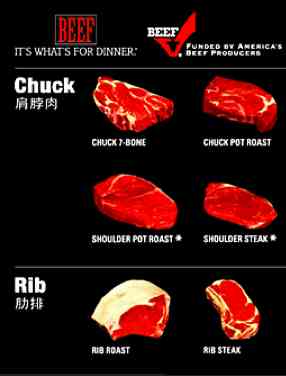 A few weeks ago, it was announced that the world's dairy prices (and anything related to that) will rise by a few percentage points. The reason being that the demand for dairy-products, most often in the form of milk-powder goods, is soaring in China.
A few weeks ago, it was announced that the world's dairy prices (and anything related to that) will rise by a few percentage points. The reason being that the demand for dairy-products, most often in the form of milk-powder goods, is soaring in China.
But it's not only milk that's hot in demand, another cow-related trend is making the rounds. Surprisingly (or perhaps not), this trend was started by McDonalds-restaurants, who have been in China since 1990. And while traditionally, the use of beef was sparingly reserved for stir-fry dishes, the Mac in McDonalds has caused a drastic taste-change towards more beef-orientated dishes.
Beef-importers would be all excited, if it wasn't for one little snag: the mad cow disease, which lead to at least a few countries being banned as beef-importers to China, including the US. This certainly can't have been comfortable for them, considering they exported around $3.19 billion worth of beef in 2003, which fell to $605 million in 2004 (after the ban), and, only in 2006, did it pass the $1 billion mark to $1.63 billion.
Time Magazine writes about how Western Cattle Company found an interesting method to get around the ban, by breeding the cows in China itself. In other words, they are exporting their know-how to Chinese farmgrounds, in the city of Hohhot, China's dairy capital, which houses two of China's biggest dairy companies, Mengniu and Yili, as well as around a million cows. The Western Cattle Company is not importing cows, it buys them, fattens them up, and its off to the slaughterhouse.
The company plays both a smart and risky game. With China's beef-consumption up 31% since 2006 alone (source: USDA), and US-imports being banned, it firmly implants itself as the leading US beef-producer in China. At the same time, several similarly-aimed joint ventures have failed in the past and a large reason is both the risk of competitors and the lack of a good supporting infrastructure. As for the first, China, as with most of Asia, clearly has a reputation for being quick on the uptake and even quicker to copy. And with a lacking standard-setting authority in China, consumers will find it hard to judge whether beef comes from an authentic source or a local competitor.
Still, beef-businesses are hopeful, that as demand soars, so must complex and hard to replicate mass-production-methods. With large quantities of beef being produced comes a new problem however, that of guaranteeing the safety of the environment. Even if the cows are kept safe, there is no guarantee that the water or air is pollution-free, and that the corn being fed to cows is clear of pesticides.
Clearly, setting up shop in China does not only depend on being there quickly, but also on being able to produce mass-quanities of goods to meet the staggering demand, doing so in a fashion which makes it hard to replicate by the locals, and implementing a lobbying campaign focussed on improving the infrastructure around your production-facility. The last of which will be a nightmare for many, I'm sure.
Filed under: Asia, business strategy, entrepreneurship, food, Globalisation, innovation, operation, retail, suppliers, technology, trends, USA
 A few weeks ago, it was announced that the world's dairy prices (and anything related to that) will rise by a few percentage points. The reason being that the demand for dairy-products, most often in the form of milk-powder goods, is soaring in China.
A few weeks ago, it was announced that the world's dairy prices (and anything related to that) will rise by a few percentage points. The reason being that the demand for dairy-products, most often in the form of milk-powder goods, is soaring in China.But it's not only milk that's hot in demand, another cow-related trend is making the rounds. Surprisingly (or perhaps not), this trend was started by McDonalds-restaurants, who have been in China since 1990. And while traditionally, the use of beef was sparingly reserved for stir-fry dishes, the Mac in McDonalds has caused a drastic taste-change towards more beef-orientated dishes.
Beef-importers would be all excited, if it wasn't for one little snag: the mad cow disease, which lead to at least a few countries being banned as beef-importers to China, including the US. This certainly can't have been comfortable for them, considering they exported around $3.19 billion worth of beef in 2003, which fell to $605 million in 2004 (after the ban), and, only in 2006, did it pass the $1 billion mark to $1.63 billion.
Time Magazine writes about how Western Cattle Company found an interesting method to get around the ban, by breeding the cows in China itself. In other words, they are exporting their know-how to Chinese farmgrounds, in the city of Hohhot, China's dairy capital, which houses two of China's biggest dairy companies, Mengniu and Yili, as well as around a million cows. The Western Cattle Company is not importing cows, it buys them, fattens them up, and its off to the slaughterhouse.
The company plays both a smart and risky game. With China's beef-consumption up 31% since 2006 alone (source: USDA), and US-imports being banned, it firmly implants itself as the leading US beef-producer in China. At the same time, several similarly-aimed joint ventures have failed in the past and a large reason is both the risk of competitors and the lack of a good supporting infrastructure. As for the first, China, as with most of Asia, clearly has a reputation for being quick on the uptake and even quicker to copy. And with a lacking standard-setting authority in China, consumers will find it hard to judge whether beef comes from an authentic source or a local competitor.
Still, beef-businesses are hopeful, that as demand soars, so must complex and hard to replicate mass-production-methods. With large quantities of beef being produced comes a new problem however, that of guaranteeing the safety of the environment. Even if the cows are kept safe, there is no guarantee that the water or air is pollution-free, and that the corn being fed to cows is clear of pesticides.
Clearly, setting up shop in China does not only depend on being there quickly, but also on being able to produce mass-quanities of goods to meet the staggering demand, doing so in a fashion which makes it hard to replicate by the locals, and implementing a lobbying campaign focussed on improving the infrastructure around your production-facility. The last of which will be a nightmare for many, I'm sure.
 The
The 

